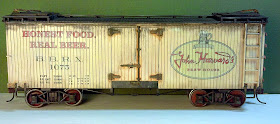Pictures always tell the story better than me so here we go:
 |
| The John Howard Refrigerator Car |
 |
| A quick fade using thinned down Liquitex ink |
 |
| Adding some soot, I think I over did it at this point |
 |
| The other side |
 |
| Adding some dirt to the bottom |
 |
| Added some rust but overall not feeling good about it |
 |
| Trying to get the soot to streak down between the boards |
 |
| Happier with this now |
 |
| The beauty shots |













































